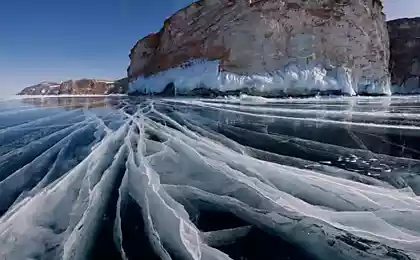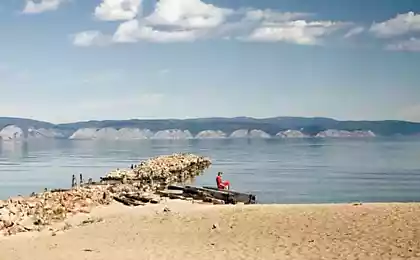230
Is it true that water from Baikal can be drunk?
Lake Baikal is a real treasure of Eastern Siberia. In addition to the famous name and landscapes, there are many facts about Baikal that will make you look at the lake from a new point of view.

As a rule, in the autumn-winter period for 5 months, stormy weather with strong wind prevails on Baikal. During a storm, the height of the waves can reach from 4 to 5 meters. And gusts of wind can strike from different sides at the same time and thereby cause irreparable damage to ships and berths. The duration of such storms up to 10 days.
The largest crash on Baikal occurred on October 15, 1901 near Cape Mare's head. The powerful wind of Baikal Sarma smashed the steamer Yakov against the rocks. He came from Verkhneangarsk (modern Nizhneangarsk) and led in tow 3 ships: Potapov, Mogilev and Shipunov.
View this post on Instagram
A post shared by Little Chalet / Little Chalet (@_little_chalet_)
There are facts about Baikal that are not only surprising, but also intriguing. At the same place near the island of Olkhon, a certain funnel is formed, which causes primitive fear among local residents, and wrinkles on the foreheads of scientists.
So far, little is known about this phenomenon. But researchers believe that it can occur either due to the collision of two currents, or due to local dips, which when filled with water form a small whirlpool.
The depth of Baikal is the deepest lake in the world. Its depth is as much as 1642 meters, which gives a head start to many seas and exceeds the height of the Eiffel Tower by 5 times. It is believed that the lake was formed in the tectonic fault of the earth's crust. This rift filled with water and thus found its depth.
Following Baikal is the African Lake Tanganyika with a depth of 1470 meters.
View this post on Instagram
A post shared by Julia Proshkina | Photo by UFA (@yulia.proshkina)
Only some 8 million years ago, Baikal was in the subtropics. The weather was about the same as in northern India: an average annual temperature of 24 ° C, palm trees, gingkos and flowers like magnolia or even lotuses grew along the shores.
Nowadays, the warmest section of Lake Baikal boasts an average annual temperature of 0.4 °C. But with climate change, it is possible that the subtropics will again cover the territory of the lake.
Lake Baikal is so huge that even if each inhabitant of the Earth spent 500 liters a day, there would be enough water for everyone for 40 years. That's 20 percent of the world's fresh water supply, which is incredibly much for a single body of water.
In addition, the water in Baikal is one of the cleanest in the world. This is due to the population of the lake - crustaceans called epishura. They are no more than 1.5 mm in size, but their population is more than 80% of all living creatures in the lake, and the main food is bacteria and single-celled algae. During the day, one such crustacean cleans a glass of water.
View this post on Instagram
A post shared by FatHippo (@tolstiybegemot)
The Baikal earthquake is located in the seismic zone. Because of this, its shores are subject to very frequent earthquakes (up to 8,000 per year). Usually their power does not exceed 2 points, but, unfortunately, there are no exceptions.
In 1862, the Tsagan earthquake occurred, which is boldly under water about 200 km2. On this territory there were 6 Buryat yurts and more than a thousand people. Now this formed bay is called the Failure.
The lake is unique not only for its size, but also for its inhabitants. The huge variety and uniqueness of life varieties became one of the reasons for the inclusion of Baikal in the UNESCO World Heritage List.
The area around the lake is covered mostly with coniferous trees such as pine, spruce, alder and larch. From the animal world there live wolves, wolverines, lynxes, boars, stoats, bears, foxes and moose. And in the lake itself you can find sturgeon, pike, nalima and omul.
View this post on Instagram
A post shared by Oleg Kostyunin (@kostyunin_photography)
Baikal has the shape of a huge crescent, and no one has yet managed to swim across it completely. And it is not a huge distance, but in the low temperature of the water. However, people do not give up trying to overcome the lake. The last record was set by a German lawyer who managed to swim 50 kilometers in 2018.
The uniqueness of ice on Lake Baikal in its transparency. Walking along it, you can easily see what is happening at a depth of 40 meters. Of course, this does not apply to the whole lake, but you can see fish. And when the ice is covered with long cracks throughout the lake, a very loud sound is heard, resembling thunder or a cannon shot.
Such cracks can be up to 2 meters wide, and up to 10 kilometers long. Thanks to them, air enters the lake, which helps to survive underwater inhabitants.
View this post on Instagram
A post shared by Tatyana Chirkova (@horns_and_craft)
After taking pictures from space, scientists noticed dark circles under the ice. It is believed that there are gas volcanoes at the bottom. During an eruption, the gas rises to the surface and, when it comes into contact with ice, forms dark rings.
And by the way, in Buryat, the word "Bai Gal" means "standing fire." It is possible that millions of years ago people observed a torch of burning methane on Lake Baikal.
What other facts do you know about Baikal? Wait in the comments!

As a rule, in the autumn-winter period for 5 months, stormy weather with strong wind prevails on Baikal. During a storm, the height of the waves can reach from 4 to 5 meters. And gusts of wind can strike from different sides at the same time and thereby cause irreparable damage to ships and berths. The duration of such storms up to 10 days.
The largest crash on Baikal occurred on October 15, 1901 near Cape Mare's head. The powerful wind of Baikal Sarma smashed the steamer Yakov against the rocks. He came from Verkhneangarsk (modern Nizhneangarsk) and led in tow 3 ships: Potapov, Mogilev and Shipunov.
View this post on Instagram
A post shared by Little Chalet / Little Chalet (@_little_chalet_)
There are facts about Baikal that are not only surprising, but also intriguing. At the same place near the island of Olkhon, a certain funnel is formed, which causes primitive fear among local residents, and wrinkles on the foreheads of scientists.
So far, little is known about this phenomenon. But researchers believe that it can occur either due to the collision of two currents, or due to local dips, which when filled with water form a small whirlpool.
The depth of Baikal is the deepest lake in the world. Its depth is as much as 1642 meters, which gives a head start to many seas and exceeds the height of the Eiffel Tower by 5 times. It is believed that the lake was formed in the tectonic fault of the earth's crust. This rift filled with water and thus found its depth.
Following Baikal is the African Lake Tanganyika with a depth of 1470 meters.
View this post on Instagram
A post shared by Julia Proshkina | Photo by UFA (@yulia.proshkina)
Only some 8 million years ago, Baikal was in the subtropics. The weather was about the same as in northern India: an average annual temperature of 24 ° C, palm trees, gingkos and flowers like magnolia or even lotuses grew along the shores.
Nowadays, the warmest section of Lake Baikal boasts an average annual temperature of 0.4 °C. But with climate change, it is possible that the subtropics will again cover the territory of the lake.
Lake Baikal is so huge that even if each inhabitant of the Earth spent 500 liters a day, there would be enough water for everyone for 40 years. That's 20 percent of the world's fresh water supply, which is incredibly much for a single body of water.
In addition, the water in Baikal is one of the cleanest in the world. This is due to the population of the lake - crustaceans called epishura. They are no more than 1.5 mm in size, but their population is more than 80% of all living creatures in the lake, and the main food is bacteria and single-celled algae. During the day, one such crustacean cleans a glass of water.
View this post on Instagram
A post shared by FatHippo (@tolstiybegemot)
The Baikal earthquake is located in the seismic zone. Because of this, its shores are subject to very frequent earthquakes (up to 8,000 per year). Usually their power does not exceed 2 points, but, unfortunately, there are no exceptions.
In 1862, the Tsagan earthquake occurred, which is boldly under water about 200 km2. On this territory there were 6 Buryat yurts and more than a thousand people. Now this formed bay is called the Failure.
The lake is unique not only for its size, but also for its inhabitants. The huge variety and uniqueness of life varieties became one of the reasons for the inclusion of Baikal in the UNESCO World Heritage List.
The area around the lake is covered mostly with coniferous trees such as pine, spruce, alder and larch. From the animal world there live wolves, wolverines, lynxes, boars, stoats, bears, foxes and moose. And in the lake itself you can find sturgeon, pike, nalima and omul.
View this post on Instagram
A post shared by Oleg Kostyunin (@kostyunin_photography)
Baikal has the shape of a huge crescent, and no one has yet managed to swim across it completely. And it is not a huge distance, but in the low temperature of the water. However, people do not give up trying to overcome the lake. The last record was set by a German lawyer who managed to swim 50 kilometers in 2018.
The uniqueness of ice on Lake Baikal in its transparency. Walking along it, you can easily see what is happening at a depth of 40 meters. Of course, this does not apply to the whole lake, but you can see fish. And when the ice is covered with long cracks throughout the lake, a very loud sound is heard, resembling thunder or a cannon shot.
Such cracks can be up to 2 meters wide, and up to 10 kilometers long. Thanks to them, air enters the lake, which helps to survive underwater inhabitants.
View this post on Instagram
A post shared by Tatyana Chirkova (@horns_and_craft)
After taking pictures from space, scientists noticed dark circles under the ice. It is believed that there are gas volcanoes at the bottom. During an eruption, the gas rises to the surface and, when it comes into contact with ice, forms dark rings.
And by the way, in Buryat, the word "Bai Gal" means "standing fire." It is possible that millions of years ago people observed a torch of burning methane on Lake Baikal.
What other facts do you know about Baikal? Wait in the comments!
The priest taught how to lure a teenager to church if he resists and shouts
Mom baked Israeli rolls with currant jam, stored for about a week at room temperature
























